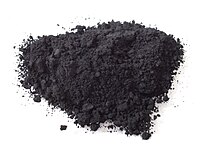
Photo from wikipedia
Highly conductive 3D ordered mesoporous Ni7 S6 -MoS2 /N-doped graphitic carbon (NGC) composite (P-NiMoS/C) microspheres are prepared as anode materials for Na-ion batteries. The rationally designed nanostructure comprises stable Ni7… Click to show full abstract
Highly conductive 3D ordered mesoporous Ni7 S6 -MoS2 /N-doped graphitic carbon (NGC) composite (P-NiMoS/C) microspheres are prepared as anode materials for Na-ion batteries. The rationally designed nanostructure comprises stable Ni7 S6 - and MoS2 -phases along with the homogeneously distributed ordered mesopores (ϕ = 50 nm) over the external and internal structures generated through thermal decomposition of polystyrene nanobeads (ϕ = 100 nm). Therefore, the P-NiMoS/C microspheres deliver initial discharge capacities of 662, 419, 373, 300, 231, 181, and 146 mA h g-1 at current densities of 0.5, 1, 2, 4, 6, 8, and 10 A g-1 , respectively. Furthermore, P-NiMoS/C exhibits a stable discharge capacity of 444 mA h g-1 at the end of the 150th cycle at a current density of 0.5 A g-1 , indicating higher cycling stability than the filled, that is, non-mesoporous, Ni3 S2 -MoS2 /NGC (F-NiMoS/C) microspheres and filled carbon-free Ni3 S2 -MoS2 (F-NiMoS) microspheres. The superior electrochemical performance of P-NiMoS/C microspheres is attributed to the rapid Na+ ion diffusion, alleviation of severe volume stress during prolonged cycling, and higher electrical conductivity of NGC, which results in fast charge transfer during the redox processes. The results in the present study can provide fundamental knowledge for the development of multicomponent, porous, and highly conductive anodes for various applications.
Journal Title: Small methods
Year Published: 2021
Link to full text (if available)
Share on Social Media: Sign Up to like & get
recommendations!